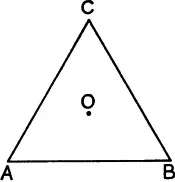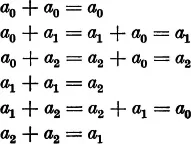
eBook - ePub
An Introduction to the Theory of Groups
Paul Alexandroff, Hazel Perfect, G.M. Petersen
This is a test
Buch teilen
- 128 Seiten
- English
- ePUB (handyfreundlich)
- Über iOS und Android verfügbar
eBook - ePub
An Introduction to the Theory of Groups
Paul Alexandroff, Hazel Perfect, G.M. Petersen
Angaben zum Buch
Buchvorschau
Inhaltsverzeichnis
Quellenangaben
Über dieses Buch
This introductory exposition of group theory by an eminent Russian mathematician is particularly suited to undergraduates, developing material of fundamental importance in a clear and rigorous fashion. The treatment is also useful as a review for more advanced students with some background in group theory.
Beginning with introductory examples of the group concept, the text advances to considerations of groups of permutations, isomorphism, cyclic subgroups, simple groups of movements, invariant subgroups, and partitioning of groups. An appendix provides elementary concepts from set theory. A wealth of simple examples, primarily geometrical, illustrate the primary concepts. Exercises at the end of each chapter provide additional reinforcement.
Beginning with introductory examples of the group concept, the text advances to considerations of groups of permutations, isomorphism, cyclic subgroups, simple groups of movements, invariant subgroups, and partitioning of groups. An appendix provides elementary concepts from set theory. A wealth of simple examples, primarily geometrical, illustrate the primary concepts. Exercises at the end of each chapter provide additional reinforcement.
Häufig gestellte Fragen
Wie kann ich mein Abo kündigen?
Gehe einfach zum Kontobereich in den Einstellungen und klicke auf „Abo kündigen“ – ganz einfach. Nachdem du gekündigt hast, bleibt deine Mitgliedschaft für den verbleibenden Abozeitraum, den du bereits bezahlt hast, aktiv. Mehr Informationen hier.
(Wie) Kann ich Bücher herunterladen?
Derzeit stehen all unsere auf Mobilgeräte reagierenden ePub-Bücher zum Download über die App zur Verfügung. Die meisten unserer PDFs stehen ebenfalls zum Download bereit; wir arbeiten daran, auch die übrigen PDFs zum Download anzubieten, bei denen dies aktuell noch nicht möglich ist. Weitere Informationen hier.
Welcher Unterschied besteht bei den Preisen zwischen den Aboplänen?
Mit beiden Aboplänen erhältst du vollen Zugang zur Bibliothek und allen Funktionen von Perlego. Die einzigen Unterschiede bestehen im Preis und dem Abozeitraum: Mit dem Jahresabo sparst du auf 12 Monate gerechnet im Vergleich zum Monatsabo rund 30 %.
Was ist Perlego?
Wir sind ein Online-Abodienst für Lehrbücher, bei dem du für weniger als den Preis eines einzelnen Buches pro Monat Zugang zu einer ganzen Online-Bibliothek erhältst. Mit über 1 Million Büchern zu über 1.000 verschiedenen Themen haben wir bestimmt alles, was du brauchst! Weitere Informationen hier.
Unterstützt Perlego Text-zu-Sprache?
Achte auf das Symbol zum Vorlesen in deinem nächsten Buch, um zu sehen, ob du es dir auch anhören kannst. Bei diesem Tool wird dir Text laut vorgelesen, wobei der Text beim Vorlesen auch grafisch hervorgehoben wird. Du kannst das Vorlesen jederzeit anhalten, beschleunigen und verlangsamen. Weitere Informationen hier.
Ist An Introduction to the Theory of Groups als Online-PDF/ePub verfügbar?
Ja, du hast Zugang zu An Introduction to the Theory of Groups von Paul Alexandroff, Hazel Perfect, G.M. Petersen im PDF- und/oder ePub-Format sowie zu anderen beliebten Büchern aus Matematica & Teoria degli insiemi. Aus unserem Katalog stehen dir über 1 Million Bücher zur Verfügung.
Information
Thema
MatematicaThema
Teoria degli insiemiChapter I
THE GROUP CONCEPT
§ 1. Introductory examples
1. Operations with whole numbers
The addition of whole numbers * satisfies the following conditions, which we call axioms of addition and which are of very great importance for all that follows:
I. Two numbers can be added together (i.e. to any two arbitrary numbers a and b there corresponds a uniquely determined number, which we call their sum: a + b).
II. The Associative Law:
For any three arbitrary numbers a, b, c we have the following identity

III. Among the numbers there is a uniquely determined number 0, the zero, which is such that for every number a the relation

is satisfied.
IV. To every number a there corresponds a so-called inverse (or negative) number —a, which has the property that the sum a + (—a) is equal to zero:

Finally yet another important condition is satisfied.
V. The Commutative Law:

2. The rotations of an equilateral triangle
We show that it is possible to add not only numbers but also many other kinds of things, and that the above conditions remain satisfied.
First Example.—We consider all possible rotations of an equilateral triangle ABC about its centroid 0 (fig. 1). We agree to call two rotations identical if they only differ from one another by a whole number of complete revolutions (and therefore by an integral multiple of 360°*). We see without difficulty that of all possible rotations of the triangle only three rotations send it into coincidence with itself, namely, the rotations through 120°, 240°, and the so-called zero rotation, which leaves all the vertices unchanged and hence also all the sides of the triangle. The first rotation sends the vertex A into the vertex B, the vertex B into the vertex C, the vertex C into the vertex A (we say that it permutes cyclically the vertices A, B, C). The second rotation sends A into C, B into A, C into B, and therefore permutes A,C,B cyclically.

Fig. 1
Now we introduce the following natural definition: The addition of two rotations means their successive application, the first rotation followed by the second. If we add the rotation through 120° to itself, then the result is the rotation through 240°; if we add to it the rotation through 240°, then the result is the rotation through 360°, the zero rotation. Two rotations through 240° result in the rotation through 480° = 360° + 120°; their sum is therefore the rotation through 120°. If we denote the zero rotation by a0, the rotation through 120° by a1, the rotation through 240° by a2, then we obtain the following relations:

Thus the sum of any two of the rotations a0, a1, a2 is defined and is again one of the rotations a0, a1, a2 We easily convince ourselves that this addition satisfies the associative law and evidently also the commutative law. Further, there exists among these rotations a0, a1, a2 a zero rotation a0 which satisfies the...